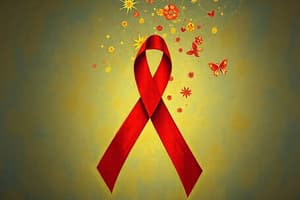Podcast
Questions and Answers
How does HIV weaken the body?
How does HIV weaken the body?
- By damaging the digestive system
- By attacking the immune system (correct)
- By affecting the respiratory system
- By targeting the nervous system
What is the consequence of untreated HIV infection?
What is the consequence of untreated HIV infection?
- It leads to diabetes
- It causes heart disease
- It progresses to AIDS (correct)
- It results in liver failure
How is HIV primarily transmitted?
How is HIV primarily transmitted?
- Casual physical contact
- Sharing contaminated food
- Sexual contact with an infected person (correct)
- Airborne droplets
Which cells of the immune system are targeted by HIV?
Which cells of the immune system are targeted by HIV?
What is the mode of transmission with the highest risk per contact?
What is the mode of transmission with the highest risk per contact?
Why may transmission rates of HIV differ between developed and developing countries?
Why may transmission rates of HIV differ between developed and developing countries?
What is one key intervention in preventing the spread of HIV mentioned in the text?
What is one key intervention in preventing the spread of HIV mentioned in the text?
Which medication can lower the risk of catching HIV, especially among high-risk individuals?
Which medication can lower the risk of catching HIV, especially among high-risk individuals?
What is the primary focus of treatment for individuals with HIV?
What is the primary focus of treatment for individuals with HIV?
What is the role of antiretroviral therapy (ART) in individuals already infected with HIV?
What is the role of antiretroviral therapy (ART) in individuals already infected with HIV?
Which population does HIV/AIDS disproportionately affect according to the text?
Which population does HIV/AIDS disproportionately affect according to the text?
What impact does HIV/AIDS have on global health, as mentioned in the text?
What impact does HIV/AIDS have on global health, as mentioned in the text?
Flashcards are hidden until you start studying
Study Notes
Communicable Diseases
Communicable diseases refer to illnesses that spread from person to person through contact with infected people, animals, food, water, or other vectors. These diseases can have serious consequences if not prevented or treated promptly. Here is some information on communicable diseases, specifically HIV/AIDS.
HIV/AIDS Overview
HIV, or human immunodeficiency virus, attacks the immune system and weakens the body's ability to fight off common infections. If left untreated, it progresses to AIDS (acquired immunodeficiency syndrome), which leads to numerous opportunistic infections and cancer. HIV infection occurs when cells of the immune system called T-helper cells (CD4+) are killed by the virus, leaving the individual susceptible to various infections.
Transmission
HIV is primarily transmitted through sexual contact with an infected person, sharing needles contaminated with infected blood, or from mother to child during pregnancy, childbirth, or breastfeeding. However, transmission rates vary depending on the mode of transmission:
| Mode of Transmission | Risk Per Contact |
|---|---|
| Sex without protection | 0.06% - 0.12% |
| Sharing contaminated needles | Up to 2.7% |
| Mother to child | 15% - 30% |
| Occupational exposure | 0.3% |
Rates may differ between developed and developing countries based on access to prevention methods, treatment for co-infections, and overall healthcare quality.
Prevention
Preventing the spread of HIV involves several steps, including promoting safer sex practices, reducing needle use among drug users, and early diagnosis and treatment. Some key interventions include:
- Education: Educating individuals on how HIV is spread and ways to prevent it can help reduce transmission rates.
- Pre-exposure prophylaxis (PrEP): PrEP medications can lower the risk of catching HIV, especially among high-risk individuals.
- Antiretroviral therapy (ART): ART can help suppress the viral load in those already infected, making them less likely to transmit HIV to others.
- Vaccines: Although there is currently no vaccine to protect against HIV, ongoing efforts are being made to develop one.
Treatment
Since HIV does not have a cure, treatment focuses on managing the condition and reducing the risk of transmission. ART is used to slow the progression of the disease, reduce the viral load, and improve the quality of life for infected individuals.
Impact of HIV/AIDS
HIV/AIDS has had a significant impact on global health, causing orphanhood, loss of human capital, and decreased economic productivity. In 2020, there were approximately 38 million people living with HIV worldwide, with 1.5 million new infections and 680,000 deaths from the disease. The disease disproportionately affects the most vulnerable populations, including women, children, and marginalized communities.
In conclusion, communicable diseases, specifically HIV/AIDS, pose a significant threat to global health. However, through education, prevention efforts, and access to treatment, it is possible to reduce the spread and impact of these diseases.
Studying That Suits You
Use AI to generate personalized quizzes and flashcards to suit your learning preferences.





